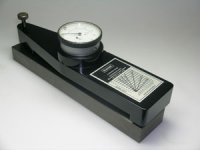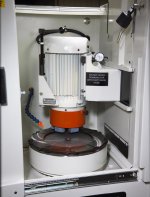my ignorance is confirmed

brucecu, you sound like youve some experience with the lapping gig. Ive a few questions if youve a moment.
When using silicon carbide etc.
Am i right in saying that larger grits fracture down to smaller grits with use? If the down force on the workpieces is correct, the abrasive will break down exposing new sharp edges as the original edges round off. Too light a pressure abrasive dulls and doesn't cut extending lapping time. Too high a down force and you have excess abrasive consumption and increase the risk of embedding abrasive in the workpiece or lapping plate. Basically, you are using a three body wear mechanism to remove material in a controlled manner.
When changing grit sizes, im guessing the same plate is used for all grits? In an ideal world you would have separate machines for each abrasive size and type. Next best is a different plate for each abrasive. Last is a common plate. It only takes one oversize grain, especially if embedded in the plate to ruin a finish and cause scratches. If you have the problem, holding a light at an oblique angle to the plate will cause the embedded particle to glint. Once you find it, it can be picked out, the plate reconditioned or the abrasive punched deeper into the plate (to irritate you another day). Don't forget to stone the resulting high spot.
Does the slurry tank and feed system need to be washed through thoroughly to avoid cross contamination when changing finer / coarser grit? Absolutely. Definitely. Unequivocably.
How would you go about polishing surface thats been lapped with Silicon carbide? Progressively finer abrasives on a felt or knapped pad. Expect some roll off at the edges of the workpiece.
When you say 'FREE abrasive machining process', does that refer to the abrasive being literally 'free' to roll around, ie not embedded in the lap surface or just thats its usually applied as a slurry? The abrasive is free to move.
Thanks.
----------------------------
I found this a quick easy read.
LabProcedures:Lapmaster12 U of T - MistiWiki




 He said let it eat. It can take it.
He said let it eat. It can take it. 




